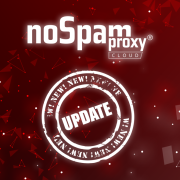The latest update further increases stability and also extends the range of functions of NoSpamProxy Cloud.
Once again, NoSpamProxy delivered a convincing performance in the VBSpam test for the second quarter of 2024. The email security suite ‘Made in Germany’ achieved a detection rate of more than 99.95% and was awarded the VBSpam+ Award.
NoSpamProxy roadshows always offer our customers and partners a great opportunity to interact directly with the NoSpamProxy team. They are also the ideal place to find out about new developments relating to NoSpamProxy solutions, exchange best practices and establish valuable contacts.
Email security is crucial for protecting personal and business information. Cyberattacks are commonplace and continue to cause major financial damage and data loss, and email remains the main entry point for attacks. So how can companies protect themselves? Here are 10 tips for maximum email security.
A vulnerability at Microsoft currently makes it possible to spoof Microsoft email addresses and thus launch credible phishing attacks on Microsoft customers. Find out how you can protect yourself in our blog.
The discussions surrounding the possible introduction of a “digital euro” are currently being used as an attack vector for phishing campaigns. Among others, fake websites of the KfW development bank, the European Central Bank, the non-profit consumer organization Stiftung Warentest and the business magazine Capital are being used.
Opening menus, paying parking fees, gaining entry to events, calling up information or logging into a WLAN, all this is possible with the help of QR codes. QR codes are practical, but can also be misused for criminal purposes: So-called “quishing” is now a widespread method used by fraudsters to obtain sensitive information such as usernames, passwords and credit card details. We explain how quishing works and how you can protect yourself in our blog post.
The latest update extends the functionality of the Outlook Add-in to include encryption and signature functions, among other things. This means that shared stack customers can now also use features that were previously reserved for NoSpamProxy Server and Private Stack customers.
NoSpamProxy
Categories
Latest News
 NoSpamProxy Cloud Update July 202424.07.2024 - 08:00
NoSpamProxy Cloud Update July 202424.07.2024 - 08:00 NoSpamProxy receives VBSpam+ Award (Q2/2024)23.07.2024 - 10:00
NoSpamProxy receives VBSpam+ Award (Q2/2024)23.07.2024 - 10:00 Looking back at the NoSpamProxy Roadshow 202401.07.2024 - 10:02
Looking back at the NoSpamProxy Roadshow 202401.07.2024 - 10:02







